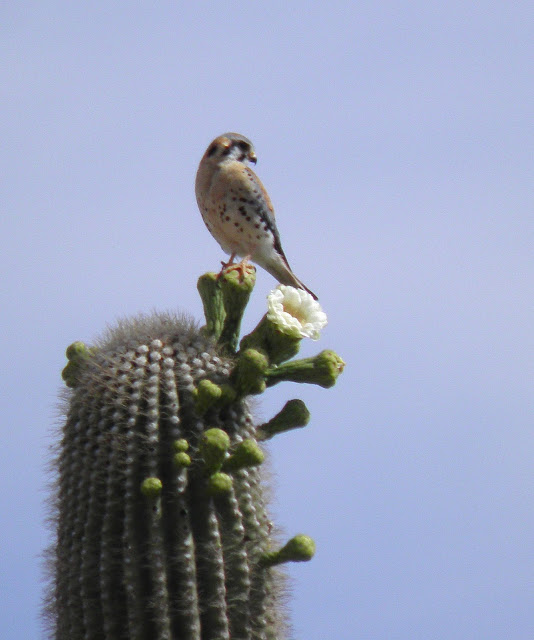It's time for the Kissing Bug post again: Yes, we have them in the Southwest US.
In the Soutwestern US, they are neither new nor uncommon.
They may carry the microbe that causes Chagas desease (Trypanosoma cruzi) in fact, studies showed that
about 40 % of the Kissing Bugs around Tucson are infected
with Trypanosoma cruzi. .But so far they are not known to transmit it to humans here in AZ. Behavioral differences from tropical species may play a role.
Some possible cases in Texas were reported (there are different species of Kissing Bugs there, the same genus, Triatoma, plus some others.)
They may carry the microbe that causes Chagas desease (Trypanosoma cruzi) in fact, studies showed that
about 40 % of the Kissing Bugs around Tucson are infected
with Trypanosoma cruzi. .But so far they are not known to transmit it to humans here in AZ. Behavioral differences from tropical species may play a role.
Some possible cases in Texas were reported (there are different species of Kissing Bugs there, the same genus, Triatoma, plus some others.)
 |
| Female Triatoma rubida in Tucson, AZ |
Adult Kissing Bugs fly to lights at this time of the year, from the end of May to the beginning of July. They are NIGHT-ACTIVE. But I have found them sitting under our kitchen light in the morning, still there from their nightly visit. They are very flat and can get through narrow openings under doors.
 |
| Nymph of T. rubida, stilll flightless |
I've found nymphs (flightless) indoors since January. The dogs may bring them in? We have packrat middens too close to the house and should get rid of those. That's were most Kissing Bugs grow up.
Taxonomically, Kissing bugs belong to the order Hemiptera,
so they are True Bugs, not Beetles. One characteristic of that group are the piercing, sucking mouth parts.
Several other True Bugs are often mistaken for Kissing Bugs
Let's separate the Kissing Bugs, also called Conenoses, from similar True Bugs that are often mixed up with the real thing.
 |
| Side view of the elongate head of a Kissing Bug (conenose) At rest, the sucking mouth parts are folded back. They stretch forward when in use. Photo by Eric Eaton (detail) |
so they are True Bugs, not Beetles. One characteristic of that group are the piercing, sucking mouth parts.
Several other True Bugs are often mistaken for Kissing Bugs
Let's separate the Kissing Bugs, also called Conenoses, from similar True Bugs that are often mixed up with the real thing.
 |
| Eastern Boxelder Bugs Photo by Seth Ausubel |
Some hints: if you find bugs on flowers, or anywhere in the sunshine, bugs in big aggregations, on leaves or fruit: Those are NOT Kissing Bugs. Several related species of these
Rhopalidae (Scentless Plant Bugs) and similar Lygaeidae (Seed Bugs) are very common in Arizona. They feed on leaves and milky, fresh seeds piercing them with their probosces and sucking the juice.
Rhopalidae (Scentless Plant Bugs) and similar Lygaeidae (Seed Bugs) are very common in Arizona. They feed on leaves and milky, fresh seeds piercing them with their probosces and sucking the juice.
Here are the Small and the Large Milkweed Bug. They are plant suckers and not interested in animal blood at all. Both are smaller than our common Kissing Bugs in AZ.
 |
| Some of our Leaf-footed Bugsdon't have actual 'leaves' on their legs |
A number of Leaf-footed Bugs (Coreidae) is as large or larger than Kissing Bugs and shape and coloring may be similar. If you see flanges (leaves) along the hind legs, the separation is easy, but not all Coreids actually have those. The large ones feed on fruit and cactus pads, often in aggregations, usually during the day
 |
| Some Assassin Bugs found in Arizona may resemble Kissing Bugs |
Remember that
Kissing Bugs are Assassin Bugs, but not all Assassin Bugs are Kissing Bugs!
Most Assassin Bugs are predators of other arthropods. Many Assassins look similar to Kissing Bugs. They can be of similar size and also share a similar color scheme of red on black. If you look closely, their heads are not cone shaped like those of the Kissing Bugs. Hint: if a predatory Assassin Bug bites you it hurts very much.
If a kissing Bug bites you, it's completely painless and usually goes unnoticed.
Itching welts and inflammations may appear later. The strength of the reaction is dependent on the immune reaction of the victim. Over time, after repeated exposure, hypersensitivity can be developed and a person becomes allergic. These allergic reactions can be severe.
Here is Triatoma rubida, our most common Kissing Bug, feeding on a Mediterranean Gecko. The reptile made no effort to avoid the painless bite. The bug injects an anesthetic and an anticoagulant.
We have 3 or 4 species of Kissing Bugs here, all in the genus Triatoma, In Tucson proper you'll see most likely Triatoma rubida, In Madera Canyon T. protracta is quite common, T recurva I have found at Clear Creek in Yavapai Co. All are night active and come to lights.
My blog should help you to better identify the bugs you find. To learn more about Chagas disease and the status of vector infection in AZ, I suggest the paper 'Infection of Kissing Bugs with Trypanosoma cruzi, Tucson, Arizona, USA' by Carolina Reisenman et al.
My blog should help you to better identify the bugs you find. To learn more about Chagas disease and the status of vector infection in AZ, I suggest the paper 'Infection of Kissing Bugs with Trypanosoma cruzi, Tucson, Arizona, USA' by Carolina Reisenman et al.

















































